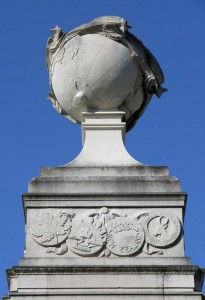
The Arras Flying Memorial features a flight of doves upon the globe. The doves follow the exact path of the sun on Armistice day: 11th November 1918.
What is it about the film Longitude that continually rewards my spirit? I enjoy watching the film jump from one time period to the next as we watch both the invention and conservation of John Harrison’s timepieces. Though I marvel at a mind that can think so many things and can think of so many new things, what really captures me in this film study?
It is the way in which Jeremy Irons, as Rupert Gould, captures the spirit of a “thing” an object, an artefact. Irons, in his portrayal, reminds me very much of the genuinely interested curator. Gould was not originally an expert, but became one because..he became interested. I can watch as Irons marvels at the timepiece’s works, its complex simplicity, the movement of its balances and wheels. In showing his first completed conservation of Harrison’s first timepiece, how it is a joy for Gould and others to watch, how the “thing” becomes, or should I say, is the story.
The story of Piper James Cleland Richardson’s pipes is very similar to the telling of Harrison’s timepieces. Richardson’s pipes are a gift to us all, having been found upon a field of battle, taken to Scotland, identified (because someone became interested) and after so many years returned to British Columbia. Placed on public exhibition within the rotunda of the province’s Parliament Building, the pipes are amongst kindred memorials, and regimental colours of British Columbia. There is a magic in these “things”, these pipes and timepieces, a spirit of their human contemporaries that captures the heart and soul to this day.
As the clocks strike the first bells at 11:00 A.M. on a chilly November day, the piper’s lament plays a short while later.
Tags: Curators, Film History, James Cleland Richardson, Jeremy Irons, Longitude, pipers, Timepieces
This entry was posted by pferguson
on Thursday, December 8th, 2011 at 7:44 pm and is filed under Our Thoughts.
You can follow any responses to this entry through the RSS 2.0 feed.
You can leave a response, or trackback from your own site.
About The Author

Paul has worked with the Paradigm Motion Picture Company since 2009 as producer, historian and research specialist. Paul first met Casey and Ian WIlliams of Paradigm in April 2007 at Ieper (Ypres), Belgium when ceremonies were being held for the re-dedication of the Vimy Memorial, France.
Paul's sensitivity to film was developed at an early age seeing his first films at RCAF Zweibrucken, Germany and Sardinia. Paul returned to Canada in 1967 and was captivated by David Lean's "Lawrence of Arabia" and "Bridge on the River Kwai". Over time Paul became increasingly interested in storytelling, content development, character, direction, cinematography, narration and soundtracks.
At the University of Victoria, Paul studied and compared Japanese and Australian film and became interested in Australian film maker Peter Weir and his film "Gallipoli" (1981). Paul was inspired when he learned Weir visited the beaches, ridges and ravines of the peninsula. "Gallipoli", the film, led Paul on many journeys to sites of conflict in England, France, Belgium, Holland, Germany, Malta, Hawaii, Gallipoli, North Macedonia and Salonika.
When Paul first watched documentary filmmaker Ken Burns, "The Civil War", Paul understood how his own experience and insight could be effective and perhaps influential in film-making. Combining his knowledge of Museums and Archives, exhibitions and idea strategies with his film interests was a natural progression.
Paul thinks like a film-maker. His passion for history and storytelling brings to Paradigm an eye (and ear) to the keen and sensitive interests of; content development, the understanding of successful and relational use of collections, imagery and voice. Like Paul's favorite actor, Peter O'Toole, Paul believes in the adage “To deepen not broaden.”
While on this path Paul always remembers his grandmother whose father did not return from the Great War and how his loss shaped her life and how her experience continues to guide him.


Comments